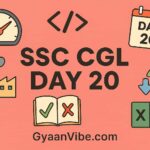GyaanVibe is a focused educational platform dedicated to helping SSC CGL aspirants crack Tier 1 & Tier 2 exam with a strategic, day-wise, and well-structured preparation approach.
SSC CGL Preparation – Day 1
Computer Basics – Organization of a Computer
🔹 What is a Computer?
A computer is an electronic device that can process, store, and retrieve data according to instructions provided to it. It performs four main operations:
- Input: Receiving data.
- Processing: Manipulating data according to instructions.
- Storage: Saving data and instructions.
- Output: Producing results.
🔹 Functional Organization of a Computer
A typical computer system is organized into five basic units:
| Unit | Function |
|---|---|
| 1. Input Unit | Takes input from user (e.g., keyboard, mouse). |
| 2. Output Unit | Shows results to user (e.g., monitor, printer). |
| 3. Memory/Storage Unit | Stores data and instructions (RAM, hard disk). |
| 4. Control Unit | Manages and coordinates all units. |
| 5. Arithmetic and Logic Unit (ALU) | Performs calculations and logical comparisons. |
🔹 Basic Components of a Computer
| Component | Details |
|---|---|
| Hardware | Physical parts of a computer (CPU, RAM, Hard disk, Keyboard, Mouse). |
| Software | Set of instructions/programs to operate hardware and perform tasks (Windows, MS Word). |
| Firmware | Special software permanently stored in hardware (e.g., BIOS). |
| Humanware | People who use computers (users, programmers, technicians). |
🔹 Block Diagram of Computer Organization
Here’s how the different units work together:
mathematicaCopyEditInput Devices ➔ Central Processing Unit (CU + ALU) ➔ Memory ➔ Output Devices
- Input Devices: Feed data (Keyboard, Mouse, Scanner).
- Central Processing Unit (CPU):
- Control Unit (CU): Directs operation.
- Arithmetic and Logic Unit (ALU): Performs all calculations.
- Memory:
- Primary Memory (RAM, ROM)
- Secondary Memory (Hard disk, Pen drive)
- Output Devices: Display/print the results (Monitor, Printer).
🔹 Characteristics of a Computer
| Feature | Explanation |
|---|---|
| Speed | Processes millions of instructions per second. |
| Accuracy | Very high accuracy if programmed correctly. |
| Automation | Can perform tasks automatically once programmed. |
| Storage | Stores a huge amount of data permanently. |
| Versatility | Can perform different types of tasks. |
| Multitasking | Handles multiple tasks at once. |
| Diligence | No tiredness or lack of concentration. |
🔹 Types of Computers (Based on Size)
| Type | Example | Features |
|---|---|---|
| Supercomputer | PARAM, IBM Summit | Extremely powerful, used for research. |
| Mainframe | IBM Z | Large organizations for bulk data. |
| Minicomputer | PDP-11 | Mid-sized business tasks. |
| Microcomputer | Desktop, Laptop | Personal computers for everyday use. |
🔹 Conclusion
Understanding the organization of a computer gives you the base to explore more complex topics like memory, CPU functioning, and cyber security.
Remember the 5 core functional units and basic block diagram, as they are frequently asked in SSC exams.
✍️ Important SSC CGL MCQ Keywords:
- ALU
- CU
- Input/output device examples
- Hardware vs Software
- Supercomputer vs Mainframe




